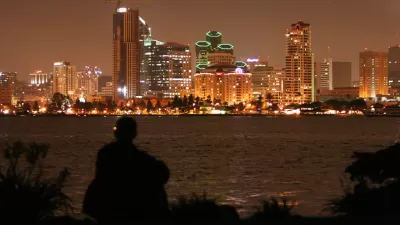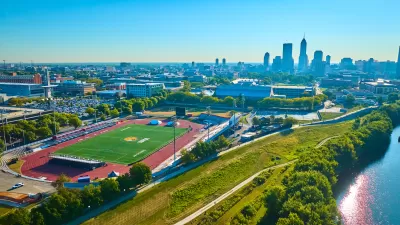In the debate over two ballot initiatives in San Diego that would facilitate a combined convention center and stadium project, proponents have pointed to Indianapolis's Lucas Oil Stadium as a successful example. But is it?
In San Diego, two ballot box planning initiatives are advancing their way to a November vote. Each could pave the way for a new downtown stadium for the Chargers combined with a convention center expansion—what is being referred to as a "Convadium." Some proponents have pointed to Indianapolis' Lucas Oil Stadium as a shining example of how stadium and convention facilities can be combined in a vibrant downtown. Local land use attorney Bill Adams decided to ask someone he knew was uniquely positioned to give insight—San Diego expat, Indiana transplant, and urban planning aficionado Walter Scott Chambers III. Walter, who had his own wonderful blog in San Diego, Great Streets San Diego, did not disappoint.
It’s really only been the last 10 years that Indianapolis development has taken off. I attribute much of the development to the completion of the Indianapolis Cultural Trail. Almost all new development in downtown has been in the proximity of the Cultural Trail.
. . . While the Northeast, Northwest, and Southeast parts of downtown have recently seen explosions in development, the Southwest area where the Stadium(s) is has yet to take off … with the exception of a few hotels.
One great feature downtown is Georgia Street – a shared space street that connects the Convention Center, the Fieldhouse, The Football Stadium, and the Cultural Trail. It has been hugely successful and should be a model for shared space streets around the nation.
The difference between Indianapolis and San Diego for downtown stadiums?
1) San Diego’s East village is already in the middle of a development boom. Instead of spurring development, a stadium in East Village would actually hinder it. Indianapolis’ stadium was built 30 years ago at a time when there was no development — or even hope for any.2) San Diego has no vision that justifies a Stadium downtown. The only reason for a Stadium in DTSD is that Spanos wants it. That’s not a vision for SD. Indy’s Stadium is in keeping with it’s vision and master-plan as a Sports City.
3) The Colts are a great, winning team. (had to rub that in).
And there was more great insight, but you'll need to go the original article for that.
FULL STORY: Is Indianapolis a good comparison for a San Diego Charger downtown stadium?

Planetizen Federal Action Tracker
A weekly monitor of how Trump’s orders and actions are impacting planners and planning in America.

Map: Where Senate Republicans Want to Sell Your Public Lands
For public land advocates, the Senate Republicans’ proposal to sell millions of acres of public land in the West is “the biggest fight of their careers.”

Restaurant Patios Were a Pandemic Win — Why Were They so Hard to Keep?
Social distancing requirements and changes in travel patterns prompted cities to pilot new uses for street and sidewalk space. Then it got complicated.

California Homeless Arrests, Citations Spike After Ruling
An investigation reveals that anti-homeless actions increased up to 500% after Grants Pass v. Johnson — even in cities claiming no policy change.

Albuquerque Route 66 Motels Become Affordable Housing
A $4 million city fund is incentivizing developers to breathe new life into derelict midcentury motels.

DC Area County Eliminates Bus Fares
Montgomery County joins a growing trend of making transit free.
Urban Design for Planners 1: Software Tools
This six-course series explores essential urban design concepts using open source software and equips planners with the tools they need to participate fully in the urban design process.
Planning for Universal Design
Learn the tools for implementing Universal Design in planning regulations.
Heyer Gruel & Associates PA
JM Goldson LLC
Custer County Colorado
City of Camden Redevelopment Agency
City of Astoria
Transportation Research & Education Center (TREC) at Portland State University
Camden Redevelopment Agency
City of Claremont
Municipality of Princeton (NJ)





























